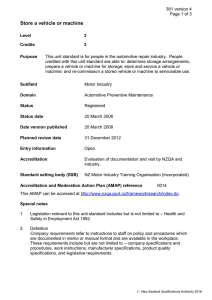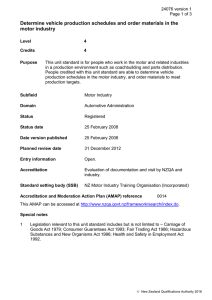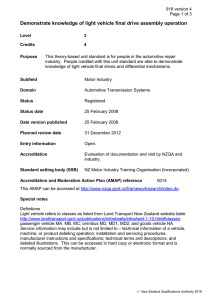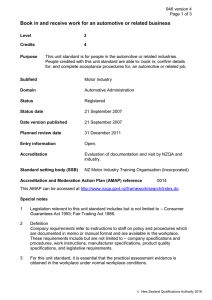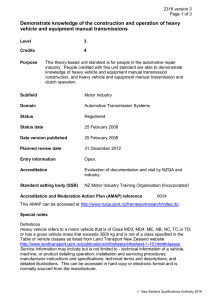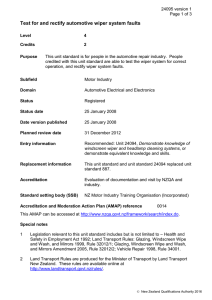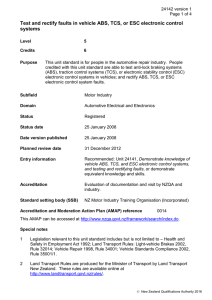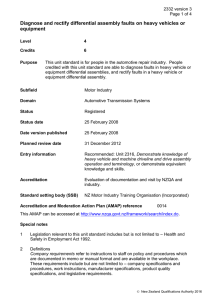Describe the construction and operation of manual and semi-automatic
advertisement
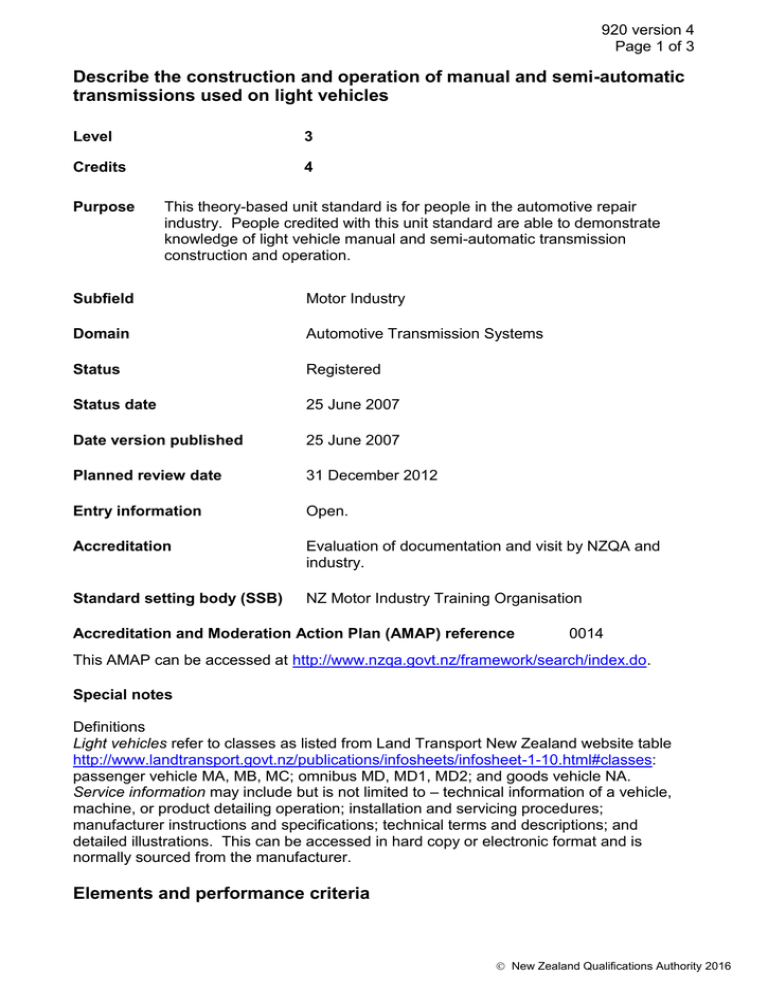
920 version 4 Page 1 of 3 Describe the construction and operation of manual and semi-automatic transmissions used on light vehicles Level 3 Credits 4 Purpose This theory-based unit standard is for people in the automotive repair industry. People credited with this unit standard are able to demonstrate knowledge of light vehicle manual and semi-automatic transmission construction and operation. Subfield Motor Industry Domain Automotive Transmission Systems Status Registered Status date 25 June 2007 Date version published 25 June 2007 Planned review date 31 December 2012 Entry information Open. Accreditation Evaluation of documentation and visit by NZQA and industry. Standard setting body (SSB) NZ Motor Industry Training Organisation Accreditation and Moderation Action Plan (AMAP) reference 0014 This AMAP can be accessed at http://www.nzqa.govt.nz/framework/search/index.do. Special notes Definitions Light vehicles refer to classes as listed from Land Transport New Zealand website table http://www.landtransport.govt.nz/publications/infosheets/infosheet-1-10.html#classes: passenger vehicle MA, MB, MC; omnibus MD, MD1, MD2; and goods vehicle NA. Service information may include but is not limited to – technical information of a vehicle, machine, or product detailing operation; installation and servicing procedures; manufacturer instructions and specifications; technical terms and descriptions; and detailed illustrations. This can be accessed in hard copy or electronic format and is normally sourced from the manufacturer. Elements and performance criteria New Zealand Qualifications Authority 2016 920 version 4 Page 2 of 3 Element 1 Demonstrate knowledge of light vehicle manual and semi-automatic transmission construction. Performance criteria 1.1 The types and application of gears are explained in accordance with service information. Range 1.2 The component parts of selector mechanisms are identified, and their function is described in accordance with service information. Range 1.3 spur, helical, double helical. rails and forks, detents, interlocks, 5th/reverse lockout, remote controls, clutch actuator. Shaft layout and location are described for an in-line transmission in accordance with service information. Range input, main, counter, reverse idler. 1.4 The purpose of a synchromesh unit is described in accordance with service information. 1.5 Methods of lubricating gears, bearings, and bushes are described in accordance with service information. Range 1.6 pressure fed, splash, sealed, impregnated. Shaft layout and the method of incorporating the final drive in a transaxle are described in accordance with service information. Element 2 Demonstrate knowledge of light vehicle manual and semi-automatic transmission operation. Performance criteria 2.1 The operation of a synchromesh unit is described in accordance with service information. Range 2.2 neutral, synchronisation, engagement. The operations of selector mechanisms are described in accordance with service information. Range selector forks, selector shaft interlocking mechanism, electric gear shift, electronic gear shift control. New Zealand Qualifications Authority 2016 920 version 4 Page 3 of 3 2.3 Power flow is traced out for any selected gear, from the input shaft to the output shaft in accordance with service information. Range in-line transmission, transaxle. Please note Providers must be accredited by NZQA, or an inter-institutional body with delegated authority for quality assurance, before they can report credits from assessment against unit standards or deliver courses of study leading to that assessment. Industry Training Organisations must be accredited by NZQA before they can register credits from assessment against unit standards. Accredited providers and Industry Training Organisations assessing against unit standards must engage with the moderation system that applies to those standards. Accreditation requirements and an outline of the moderation system that applies to this standard are outlined in the Accreditation and Moderation Action Plan (AMAP). The AMAP also includes useful information about special requirements for organisations wishing to develop education and training programmes, such as minimum qualifications for tutors and assessors, and special resource requirements. Comments on this unit standard Please contact the NZ Motor Industry Training Organisation jlane@mito.org.nz if you wish to suggest changes to the content of this unit standard. New Zealand Qualifications Authority 2016

